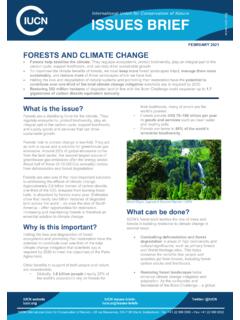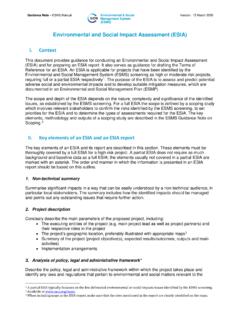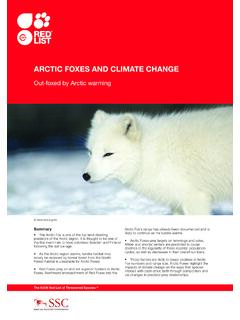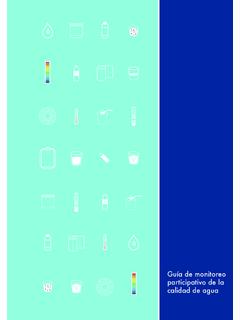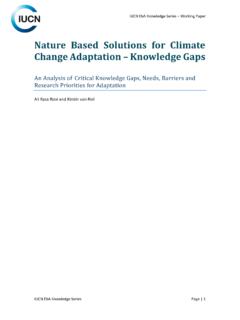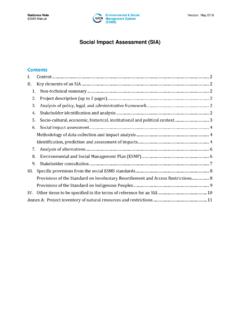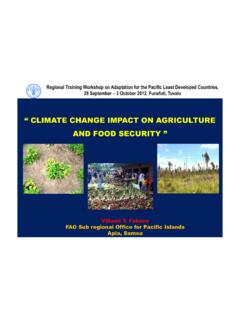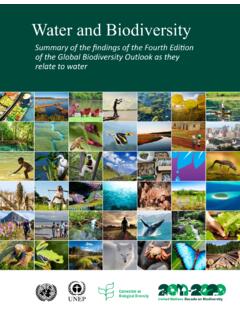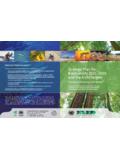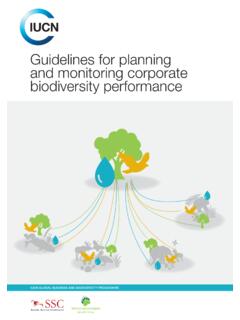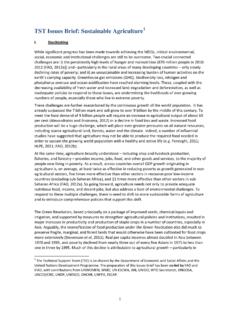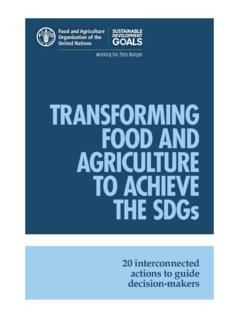Transcription of THE IUCN RED LIST OF THREATENED SPECIES™
1 Red Panda (Ailurus fulgens) VulnerablePhotography brett211 CC BY-SA IUCN RED LIST OF THREATENED SPECIES The IUCN Red List of THREATENED Species is the world s most comprehensive information source on the global conservation status of animal, fungi and plant species and their links to livelihoods. Our goal is to catalyse action for biodiversity conservation by providing information and analysis on the world s species, including threats, population status and trends. The IUCN Red List is a wake-up call, reminding us that our natural world is becoming increasingly vulnerable. We know that effective conservation can yield outstanding results, saving species from extinction while securing the livelihoods of local communities. The international community must urgently step up conservation efforts if we want to secure this fascinating diversity of life that sustains, inspires and amazes us every day.
2 Inger Andersen, IUCN Director General (International Union for Conservation of Nature).Eyelash Frog (Ceratobatrachus guentheri) Least ConcernPhotography Robin MooreAbout The IUCN Red List IUCN Red List IndexThe IUCN Red List Index (RLI) reveals trends in the overall extinction risk of species and provides an indicator that is used by governments to track their progress in achieving targets that reduce biodiversity Red List Index has been adopted by the United Nations as one of the indicators for the 2015 Millennium Development Goal 7 on environmental is also a useful tool for assessing progress towards achieving Target 12 of the Aichi biodiversity RLI is calculated from the genuine changes in IUCN Red List Categories of all assessed species in a taxon over time. A decreasing RLI value means the expected rate of extinctions is increasing ( the rate of biodiversity loss is increasing).
3 An upward trend or increasing RLI value means that there is a decrease in expected future rate of species extinctions ( a reduction in the rate of biodiversity loss). About The IUCN Red List About The IUCN Red List The IUCN Red List is a rich compendium of information on threats, ecological requirements, and habitats of species; and on conservation actions that can be taken to reduce or prevent extinctions. It is based on an objective system for assessing the risk of extinction of a species based on past, present, and projected assessments are conducted following a standardized process using the rigorous IUCN Red List Categories and Criteria, ensuring the highest standards of scientific documentation, information management, expert review, and are eight IUCN Red List Categories based on criteria linked to population trend, size and structure, and geographic range.
4 Species listed as Critically Endangered, Endangered or Vulnerable are collectively described as IN THE WILDEWVULNERABLEVUDATA DEFICIENT DDNOT EVALUATEDNEEXTINCTEXLEAST CONCERNLCNEAR THREATENEDNTENDANGEREDENCRITICALLYENDANG EREDCRG reen Turtle (Chelonia mydas) EndangeredPhotography Kathryn Pintusof Amphibiansthreatened41%of Cycadsthreatened63%of Reef-building Corals threatened33%of Conifersthreatened34%of Birdsthreatened13%of Mammalsthreatened25%Encephalartos laevifolius Critically EndangeredAcropora palmata Critically EndangeredNeocallitropsis pancheri EndangeredTarsius tumpara Critically EndangeredMergus octosetaceus Critically EndangeredPseudophilautus tanu EndangeredSpecies on The IUCN Red ListMore than 77,300 species have been assessed on The IUCN Red List. This figure includes most of the known species of amphibians; birds; mammals; angelfish; butterflyfish; crocodilians; freshwater crabs and crayfish; groupers; gymnosperms (including cycads and conifers); lobsters; mangroves; marine turtles; parrotfish; reef-building corals; seagrasses; seasnakes; sharks and rays; tunas and billfishes; and results are disturbing with several species groups facing a severe threat of extinction.
5 The services and economic value that species provide are irreplaceable and essential to our well-being. Unless we live within the limits set by nature, and manage our natural resources sustainably, more and more species will be driven towards extinction. If we ignore our responsibility we will compromise our own survival. Dr Jane Smart Director, IUCN Global Species ProgrammePhotography Robin MooreInform Policy and ConventionsGuide scientific researchThe IUCN Red List is used to inform decisions taken by Multilateral Environmental Agreements. It is often used as a guide to revise the annexes of some agreements, such as the Convention on International Trade in Endangered Species (CITES) and the Convention on Migratory Species (CMS).The IUCN Red List assessments of freshwater species have also contributed to the work of the Ramsar Convention in selecting sites that are important for freshwater IUCN Red List will contribute to the function of the Intergovernmental science-policy Platform on biodiversity and ecosystem services (IPBES) to strengthen the science-policy interface on biodiversity and ecosystem services to improve decision journals regularly cite The IUCN Red List in peer-reviewed literature.
6 Each year numerous new conservation articles examine the values of The IUCN Red List and refer to its important contribution to conservation planning. Downloads of IUCN Red List data from the website show that academics from research institutions worldwide export IUCN Red List data for research purposes on a daily is The IUCNRed List used?About The IUCN Red List The IUCN Red List PartnershipWorking together for conservationThe IUCN Red List is produced and managed by the IUCN Global Species Programme, the Species Survival Commission (SSC) and The IUCN Red List IUCN Red List partners are: BirdLife International; Botanic Gardens Conservation International; Conservation International; Microsoft; NatureServe; Royal Botanic Gardens, Kew; Sapienza University of Rome; Texas A&M University; Wildscreen; and Zoological Society of London. The IUCN Red List tells us where we ought to be concerned and where the urgent needs are to do something to prevent the despoliation of this world.
7 It is a great agenda for the work of conservationists. Sir David Attenborough IUCN Red List data are being used to report on and measure progress toward the Aichi biodiversity Targets, adopted by governments at the Conference of the Parties to the Convention on Biological Diversity (CBD), 2010 - in particular, Target 12: By 2020 the extinction of known THREATENED species has been prevented and their conservation status, particularly of those most in decline, has been improved and is The IUCN Red List used?A: Address the underlying causes of biodiversity loss by mainstreaming biodiversity across government and : Public awareness : Values of biodiversity : Incentives : Sustainable production and consumption : National biodiversity strategies and action plans : Traditional knowledge respected and reflected in the implementation of the : Knowledge and technologies improved and : Financial resources : ecosystems are restored and : By 2020, ecosystem resilience : Nagoya Protocol on Access to Genetic Resources and the Fair and Equitable Sharing of Benefits Arising from their Utilization is in Enhance the benefits to all from biodiversity and ecosystem : Protected areas : Extinction : Genetic diversity.
8 Improve the status of biodiversity by safeguarding ecosystems , species and Strategic GoalAichi Targets for 2020 IUCN Red ListB. Reduce the direct pressures on biodiversity and promote sustainable : Habitat loss : Towards sustainable management of : Sustainable management (agriculture, aquaculture and forestry).8: Pollution : Invasive alien species : Pressures on vulnerable ecosystems impacted by climate change or ocean acidification Enhance implementation through participatory planning, knowledge management and Palm-Pitviper (Bothriechis thalassinus) Not EvaluatedPhotography Robin MooreHumphead Wrasse (Cheilinus undulatus) EndangeredPhotography Christian LaufenbergHealth CareThe IUCN Red List distribution information is frequently used by researchers in the health sector to look at the distributions of species which are known or suspected vectors of human and domestic-animal diseases to develop models on predicted future occurrences of the diseases.
9 The IUCN Red List also helps to highlight those medicinal plants which are being unsustainably harvested to ensure appropriate conservation actions can be implemented to conserve these is The IUCN Red List used?The IUCN Red List shows where action needs to be taken to save the building blocks of nature from extinction. It provides a straightforward way to factor biodiversity needs into decision-making processes by providing a wealth of useful information on species. Awareness and EducationNew information from The IUCN Red List generates significant media interest resulting in hundreds of articles on the web, printed newspapers, television, radio and special interest magazines; raising public awareness of the plight of species and the larger environmental issues surrounding them. The Zoo, Aquarium and Botanic Garden networks are supporting The IUCN Red List by including the IUCN Red List status on their species information IUCN Red List website ( ) is also regularly used by educators and students of all Decision-makingThe IUCN Red List can help guide environmental impact assessments.
10 The wealth of information on habitats and threats to species are used in biodiversity management plans and site rehabilitation plans. Combining conservation planning analyses with information on threats from The IUCN Red List has also lead to partnerships with industry to explore opportunities to reduce the negative impact on biodiversity and promote more sustainable production. Initiatives of the petrochemical, mining, aggregate and financial industry such as Net Positive Impact (NPI) and No Net Loss, benefit from access to information on the distribution of species and their conservation Resource AllocationInform Conservation PlanningThe Global Environment Facility (GEF) has included information from The IUCN Red List in its resource allocation framework since 2008. Other foundations and funding instruments, such as the Critical Ecosystem Partnership Fund; SOS - Save Our Species; and Mohamed bin Zayed Species Conservation Fund also use the results of The IUCN Red List assessments to guide their investments in conservation planning methodologies use The IUCN Red List to identify important areas for conservation including: Important Bird Areas; Important Plant Areas; and Alliance for Zero Extinction sites.
